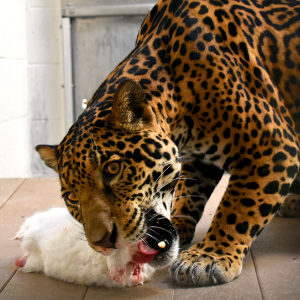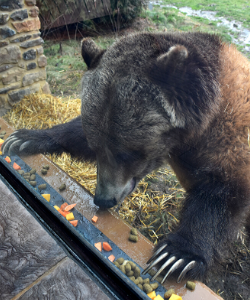Whether it’s burritos Mexicanos, Mongolian Beef, Italian cuisine, or even just a good old American cheeseburger, many of us have a go-to food that reminds us of home. As an important part of our daily routine, food can bring us feelings of satisfaction, intrigue, excitement and even comfort.
 No matter what you like to eat, we can all agree that balanced nutrition is a key part of the human diet, and animals are no different! Since every species processes nutrients differently, it is important to provide animal-specific diets to keep all of our Akron Zoo residents healthy. That's why our animal care staff work hard to provide both nutritional and desirable food items to every animal every day, and since March is National Nutrition Month, we wanted to give you an inside look!
No matter what you like to eat, we can all agree that balanced nutrition is a key part of the human diet, and animals are no different! Since every species processes nutrients differently, it is important to provide animal-specific diets to keep all of our Akron Zoo residents healthy. That's why our animal care staff work hard to provide both nutritional and desirable food items to every animal every day, and since March is National Nutrition Month, we wanted to give you an inside look!
Our animal diets were designed by Kim Cook, Senior Director of Life Sciences. Diet items are selected based on what the species eats in its natural habitat, what they may have eaten in their previous residence (if they were not born at the Akron Zoo), the diets of similar domestic species and expert advice from species-specific animal care manuals as well as the Association of Zoos and Aquariums (AZA) Nutrition Advisory Group. Using this information, we can use nutrition calculators to build a well-rounded diet for each of our residents.
 One example of using research to select diet items can be seen in our big cat diets. Cats are obligate carnivores, meaning their bodies are finely tuned to digest and process meat; it is a biological necessity. Plants, while not inherently harmful to cats, cannot be digested and therefore offer no nutritional value. To meet our big cats’ needs, we feed them three diet items: whole rabbits, which are a good substitute for the skin and organs of large prey; ground meat, representing the muscle tissue of a kill; and bones, which help our cats maintain strong jaw pressure and clean their teeth. It is very bad for cats to skip meals, as an empty stomach may cause damage to their liver, so they are fed one of these items every day!
One example of using research to select diet items can be seen in our big cat diets. Cats are obligate carnivores, meaning their bodies are finely tuned to digest and process meat; it is a biological necessity. Plants, while not inherently harmful to cats, cannot be digested and therefore offer no nutritional value. To meet our big cats’ needs, we feed them three diet items: whole rabbits, which are a good substitute for the skin and organs of large prey; ground meat, representing the muscle tissue of a kill; and bones, which help our cats maintain strong jaw pressure and clean their teeth. It is very bad for cats to skip meals, as an empty stomach may cause damage to their liver, so they are fed one of these items every day!
Since not all diet items for all of our animals can be produced locally, some of our herbivore and omnivore species also receive substitute diet items. Our giant prickly stick insects, for example, mainly eat eucalyptus leaves in their native habitat, while in human care these animals thrive on blackberry bramble leaves, which can be ordered in bulk online, or oak leaves, which grow on zoo grounds in the summer. Currently, our adult colony of roughly 50 insects eats three small branches of bramble leaves every night.
Other animals, such as our penguins, need vitamin supplements as part of their species diet. Our penguin colony is regularly fed two types of fish - capelin and smelt. Capelin makes up their main diet while smelt is more of a “dessert” fish. Unfortunately when fish is frozen, it loses some of its nutritional value, so our penguins also get a bird-specific multivitamin twice a week and vitamins B1 and E five days a week. This keeps our colony eating the food they enjoy while getting the nutrients they need!
Penguins are the second most expensive animals at the Akron Zoo to feed. The most expensive? Our bats! Seba’s short-tailed bats are opportunistic frugivores, eating a wide variety of overripe fruits, including apples, bananas, pears, grapes, melons and berries. Since flying burns a lot of calories, each individual eats up to two times their own body weight every single day to maintain their energy. The Akron Zoo is home to more than 600 of these little guys, so we are constantly ordering fresh fruit to keep them well fed! Our bats also have some unusual eating habits. Instead of consuming the entire fruit, bats suck out the juices, spitting out the pulp and seeds. That is why it is polite to spit out your food at a bat dinner party! (Don’t try this at home, though. What is polite to bats is the opposite to moms.) These eating habits allow Seba’s short-tailed bats to play an important role in both pollination and seed dispersal in their natural habitat.
 Most of our animals’ diets are reevaluated annually based on behavior, body condition, food variety and availability, and likes or dislikes. Some animals, like our bears, have a diet that changes seasonally based on how active they are and what is available in their environment. Bears are scavengers, so they eat what they can find, including berries, bugs, nuts and greens. At the zoo, our bears enjoy ground meat, fish (which they usually smear on their heads rather than eat), fruit, leafy greens and veggies. In the winter our bears only eat about 3 lbs of food a day, but in the summer Jackson and Cheyenne can each consume up to 15 lbs of food daily!
Most of our animals’ diets are reevaluated annually based on behavior, body condition, food variety and availability, and likes or dislikes. Some animals, like our bears, have a diet that changes seasonally based on how active they are and what is available in their environment. Bears are scavengers, so they eat what they can find, including berries, bugs, nuts and greens. At the zoo, our bears enjoy ground meat, fish (which they usually smear on their heads rather than eat), fruit, leafy greens and veggies. In the winter our bears only eat about 3 lbs of food a day, but in the summer Jackson and Cheyenne can each consume up to 15 lbs of food daily!
Though you may not want to dine in our animal care kitchens, animals at the Akron Zoo always get a five star experience that is nutritious and delicious! We make sure our animals receive the highest quality foods, such as fresh fruit and restaurant quality meat. Each diet is tailored specifically to the needs of the individuals, so that all of our residents stay happy and healthy!
To read about some of our other animals’ diets and learn some nutrition lessons you can apply at home, visit our Summer “Diet” blog. Or, if you are missing your favorite Akron Zoo animals, visit us on Facebook, where every day at noon we are sharing a “lunch and learn” with keeper talks and unique animal experiences. Thank you for continuing to support your Akron Zoo!
